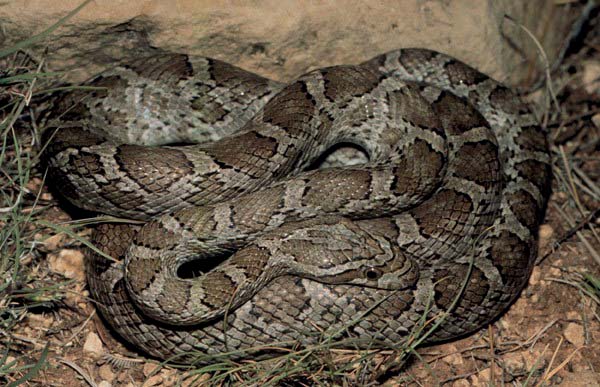
Elaphe guttata emoryi (Great Plains Ratsnake)

Photo by Troy Hibbitts, Black Belt Reptiles
Written by Troy Hibbitts
Common Names: Great Plains Ratsnake, Emory's Ratsnake
Scientific Name: Elaphe guttata emoryi
Range: The Emory's Ratsnake ranges from extreme southern Nebraska south to northern Queretaro, Mexico. It ranges from the vicinity of St. Louis, Missouri in the east to near Albuquerque, New Mexico in the west. An additional, disjunct population is also present in the Colorado and Green River valleys of western Colorado and eastern Utah.
Habitat: As its name implies, the Great Plains Ratsnake is typically an animal of the grassy plains of the midwestern United States. However, it also ranges into desert thornscrub of the Chihuahuan desert and into tropical thornscrub habitats in Mexico and South Texas. It is most abundant in sandy habitats where rock outcrops provide shelter.
Behavior: This species moves both day and night, depending upon the temperature. However, throughout much of its range, daytime temperatures exceed its tolerance levels for much of the active season, making this animal chiefly nocturnal. A brumation period of 3 months at 55 degrees fahrenheit is generally required to breed this subspecies. Breeding usually takes place in March or April, with eggs laid in late April or May. Eggs usually hatch in August. Hatchlings are much more robust than cornsnake hatchlings, having a significant yolk supply retained in their body cavities. Hatchlings feed on nestling mice quite readily after thier yolk stores have been exhausted. Adults feed primarily on rodents. The Emory's Ratsnake is not usually as arboreal as the Cornsnake, but does climb rocky cliffs with no difficulty. It spends much of its time searching for prey in rodent burrows.
Size: Hatchlings range from 8-14", and adults range from 24-48". The largest reported specimen measured right at 5 feet (60.25"). Overall, a stockier, heavier-bodied snake than a Cornsnake.
Coloration:
Wild Types:
Similar in pattern to the cornsnake, with 27-73 dorsal blotches on a gray ground color. Lateral blotches present and generally correspond in number to the number of dorsal blotches. Dorsal blotches are variable in shape and in color, varying in shape from narrow ovals to large squares, to H-shaped blotches narrower along the spine than on the sides, and varying in color from a gray only slightly darker than the ground color to olive or brown. The spearpoint on the head is similar that found on the Cornsnake, but is often broken in the middle and incomplete. In large adults, particularly in South Texas, the head pattern fades and becomes indistinct. Ventral checking is present but is generally not as intense as in the Cornsnake, with each mark often having a rounded outline rather than square, as well as a lesser percentage of the ventral surface being black.
Several wild populations have been recognized at times as distinct subspecies:
intermontana - the disjunct population from eastern Utah and western Colorado have at times been recognized as a full subspecies. It is a smaller snake, generally less than 3 feet (36") in length, and has a high dorsal blotch count (towards the 73 end of the range), with the dorsal blotches becoming narrow ovals.
meahllmorum - populations from South Texas and Mexico have at recently been assigned to a new subspecies characterized by a low blotch count (less than 45 blotches) and great reduction of ventral pattern, particularly in the throat area. In my opinion, this subspecies is poorly distinguished from emoryi, and of dubious validity.
Chocolate Corns - populations of Elaphe guttata from East Texas, East Oklahoma, Arkansas, and Central Louisiana have been variously treated Emory's Ratsnakes, intergrades, or Cornsnakes. They are reddish-brown blotched snakes on a gray ground color and have a pattern and build similar to a Cornsnake (with large blotches and heavily patterned venters) but with colors more subdued as in the Great Plain's Ratsnake.
Captive Cultivars:
The Great Plains Ratsnake is no where near as widely bred as is the cornsnake, and the number of captive produced cultivars is correspondingly fewer.
Amelanistic - recently, 2 amelanistic animals have been captured in Kansas and are being bred. In addition, a 3rd individual was caught in South Texas, and is also being bred. The Kansas strain is not the same amelanistic gene as is found in the cornsnake - it is unknown if the Texas strain is similar. The Kansas amelanistics are yellow-orange blotched snakes with a white ground color. The Texas amelanistic is a very pale animal with a yellowish-white ground with pale yellow blotches only slightly darker than the ground.
Chocolate Emory's - A single wild-caught individual with on overall brown coloration was collected in eastern Kansas and is being bred. It has a uniform brown color through which faint outlines of blotches can be seen.
Striped Emory's - emoryi in which the dorsal blotches are fused into paired lengthwise stripes. Not the same trait that produces striped cornsnakes.
Creamsicle Corns - An amelanistic Cornsnake x Great Plains Ratsnake captive bred intergrade. Generally yellow and orange amelanistics rather than red and orange as in pure cornsnakes.